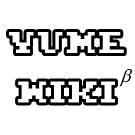Yume Wiki Style Guide
Spelling and Typography • Grammar and Usage • Tone • Links • Titles and Article Organization • Location Pages • Media • Outdated or Unused Content • Miscellaneous
The Style Guide is the descriptive standard for Yume Wiki's style and formatting conventions to ensure users edit consistently.
Editors should generally follow the contents of this guide, though some exceptions may apply. Please do not make substantive edits to this guide without consensus.
If you have questions, concerns, or suggestions about these guidelines, please use the talk page.
Contents
For ease of reading, the Style Guide has been split into separate sections.
- Spelling and Typography contains formatting conventions, mostly related to spelling, punctuation, capitalization, and special formatting conventions for numbers. It also contains our guidelines for Japanese romanization.
- Grammar and Usage contains conventions related to appropriate use of grammar on the Yume Wiki. It contains guidelines for grammatical person, grammatical tense, and contractions.
- Tone contains conventions related to creating an encyclopedic and professional tone on the Yume Wiki, and general advice for writing clearly and informatively. It also describes reliability standards for article content.
- Links contains conventions related to creating links on the Yume Wiki, to both internal and external pages.
- Titles and Article Organization contains conventions for naming and organizing articles. It also describes acceptable formats for articles.
- Location Pages contains conventions specific to creating location pages, which are the most common type of page on the Yume Wiki. It also contains all of our guidance on creating readable maps of locations.
- Media contains conventions related to uploading and formatting media on the Yume Wiki. It contains all of our guidelines for uploading images and audio, and adding galleries to pages.
- Outdated or Unused Content contains conventions related to documenting content that is inaccessible through regular gameplay or has been removed.
- Miscellaneous Guidelines contains everything that does not fit anywhere else. Specifically, it contains guidelines concerning page styling (including the use of color), the use of text in images, non-breaking spaces, the creation of pronunciation guides, and content related to badges.
